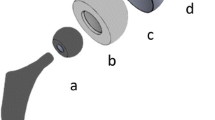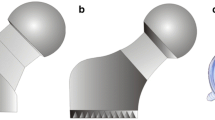Abstract
Purpose
Osteolysis in total hip arthroplasty (THA) depends on polyethylene wear and dictates the survival of the prosthesis. Dual mobility in THAs, which is claimed to reduce dislocation risk, has very good long-term clinical results. However, little is known about how the liner wears in this design, compared to the standard single mobility model.
Methods
A comparative study looking at wear of a conventional ultra-high-molecular-weight polyethylene liner, using gravimetric measurement, between dual mobility implants and standard implants, was performed on a simulator in accordance with a normed protocol based on the same dimensions, environmental conditions and stresses. A linear regression test was employed.
Results
Under the same conditions (loading, cycles, sterilization, material and surface roughness), the gravimetric wear (for conventional polyethylene) is comparable between a standard and a dual mobility cup. This correlates to ten year follow-up results of dual mobility cup.
Discussion - Conclusion
This in vitro equivalent wear serves to confirm the very good long-term clinical results observed with dual mobility bearing, whose use should not be restricted by concerns about increased polyethylene wear.





Similar content being viewed by others
References
Australian Orthopaedic Association National Joint Replacement Registry. Annual Report 2015. In AOA. Available at https://aoanjrr.sahmri.com/annual-reports-2015
Swedish Hip Arthroplasty Register (2014) Annual report. Available at http://www.shpr.se/Libraries/Documents/Annual_Report_2014_Eng.sflb.ashx
Dumbleton JH, Manley MT, Edidin AA (2002) A literature review of the association between wear rate and osteolysis in total hip arthroplasty. J Arthroplasty 17:649–661
Prudhon JL, Ferreira A, Verdier R (2013) Dual mobility cup: dislocation rate and survivorship at ten years of follow-up. Int Orthop 37:2345–2350
Boyer B, Philippot R, Geringer J, Farizon F (2012) Primary total hip arthroplasty with dual mobility socket to prevent dislocation: a 22-year follow-up of 240 hips. Int Orthop 36:511–518
Combes A, Migaud H, Girard J, Duhamel A, Fessy MH (2013) Low rate of dislocation of dual-mobility cups in primary total hip arthroplasty. Clin Orthop 471:3891–3900
Ko LM, Hozack WJ (2016) The dual mobility cup: what problems does it solve? Bone Joint J 98-B:60–63
Philippot R, Camilleri JP, Boyer B, Adam P, Farizon F (2009) The use of a dual-articulation acetabular cup system to prevent dislocation after primary total hip arthroplasty: analysis of 384 cases at a mean follow-up of 15 years. Int Orthop 33:927–932
Caton JH, Prudhon JL, Ferreira A, Aslanian T, Verdier R (2014) A comparative and retrospective study of three hundred and twenty primary Charnley type hip replacements with a minimum follow up of ten years to assess whether a dual mobility cup has a decreased dislocation risk. Int Orthop 38:1125–1129
D’Lima DD, Hermida JC, Chen PC, Colwell CW (2003) Polyethylene cross-linking by two different methods reduces acetabular liner wear in a hip joint wear simulator. J Orthop Res Off Publ Orthop Res Soc 21:761–766
Saikko V, Shen M (2010) Wear comparison between a dual mobility total hip prosthesis and a typical modular design using a hip joint simulator. Wear 268:617–621
Herrera L, Lee R, Essner A, Coustance A (2009) Wear evaluation of a dual mobility system. 55th Annual Meeting of the Orthopaedic Research Society. Avalaible at http://www.ors.org/Transactions/55/2311.pdf
Stulberg SD (2011) Dual poly liner mobility optimizes wear and stability in THA: affirms. Orthopedics 34:e445–e448
Netter JD, Hermida JC, Chen PC, Nevelos JE, D’Lima DD (2014) Effect of microseparation and third-body particles on dual-mobility crosslinked hip liner wear. J Arthroplasty 29:1849–1853
Kadaba MP, Ramakrishnan HK, Wootten ME (1990) Measurement of lower extremity kinematics during level walking. J Orthop Res Off Publ Orthop Res Soc 8:383–392
Loving L, Herrera L, Banerjee S, Heffernan C, Nevelos J, Markel DC, Mont MA (2015) Dual mobility bearings withstand loading from steeper cup-inclinations without substantial wear. J Orthop Res Off Publ Orthop Res Soc 33:398–404
Loving L, Lee RK, Herrera L, Essner AP, Nevelos JE (2013) Wear performance evaluation of a contemporary dual mobility hip bearing using multiple hip simulator testing conditions. J Arthroplasty 28:1041–1046
Philippot R, Boyer B, Farizon F (2013) Intraprosthetic dislocation: a specific complication of the dual-mobility system. Clin Orthop 471:965–970
Wroblewski BM (1986) 15-21-year results of the Charnley low-friction arthroplasty. Clin Orthop 30–35
Adam P, Farizon F, Fessy M-H (2014) Dual mobility retentive acetabular liners and wear: surface analysis of 40 retrieved polyethylene implants. Orthop Traumatol Surg Res 100:85–91
Schmalzried TP, Szuszczewicz ES, Northfield MR, Akizuki KH, Frankel RE, Belcher G, Amstutz HC (1998) Quantitative assessment of walking activity after total hip or knee replacement. J Bone Joint Surg Am 80:54–59
Willie BM, Ashrafi S, Alajbegovic S, Burnett T, Bloebaum RD (2004) Quantifying the effect of resin type and sterilization method on the degradation of ultrahigh molecular weight polyethylene after 4 years of real-time shelf aging. J Biomed Mater Res A 69:477–489
Jin ZM, Dowson D, Fisher J (1994) A parametric analysis of the contact stress in ultra-high molecular weight polyethylene acetabular cups. Med Eng Phys 16:398–405
D’Apuzzo MR, Koch CN, Esposito CI, Elpers ME, Wright TM, Westrich GH (2016) Assessment of damage on a dual mobility acetabular system. J Arthroplasty 31:1828–1835
Nakata K, Ohzono K, Masuhara K, Matsui M, Hiroshima K, Ochi T (1997) Acetabular osteolysis and migration in bipolar arthroplasty of the hip: five- to 13-year follow-up study. J Bone Joint Surg (Br) 79:258–264
Herrera L, Lee R, Longaray J, Essner A (2010) Edge loading wear due to inclination angle for three contemporary Hip Bearings. 56th Annual Meeting of the Orthopaedic Research Society. Available at http://www.ors.org/Transactions/56/2259.pdf
Fabry C, Kaehler M, Herrmann S, Woernle C, Bader R (2014) Dynamic behavior of tripolar hip endoprostheses under physiological conditions and their effect on stability. Med Eng Phys 36:65–71
Fabry C, Woernle C, Bader R (2014) Self-centering dual-mobility total hip systems: prediction of relative movements and realignment of different intermediate components. Proc Inst Mech Eng H 228:477–485
Geringer J, Boyer B, Farizon F (2011) Understanding the dual mobility concept for total hip arthroplasty. Investigations on a multiscale analysis-highlighting the role of arthrofibrosis. Wear 271:2379–2385
Lecuire F, Benareau I, Rubini J, Basso M (2004) Intra-prosthetic dislocation of the Bousquet dual mobility socket. Rev Chir Orthop Reparatrice Appar Mot 90:249–255
Fabry C, Langlois J, Hamadouche M, Bader R (2016) Intra-prosthetic dislocation of dual-mobility cups after total hip arthroplasty: potential causes from a clinical and biomechanical perspective. Int Orthop 40:901–906
Leclercq S, Benoit JY, de Rosa JP, Tallier E, Leteurtre C, Girardin PH (2013) Evora® chromium-cobalt dual mobility socket: results at a minimum 10 years’ follow-up. Orthop Traumatol Surg Res 99:923–928
Vielpeau C, Lebel B, Ardouin L, Burdin G, Lautridou C (2011) The dual mobility socket concept: experience with 668 cases. Int Orthop 35:225–230
Scifert CF, Brown TD, Pedersen DR, Callaghan JJ (1998) A finite element analysis of factors i nfluencing total hip dislocation. Clin Orthop 152–162
Massin P, Achour S (2016) Wear products of total hip arthroplasty: the case of polyethylene. Morphol Bull Assoc Anat
Rowell SL, Reyes CR, Malchau H, Muratoglu OK (2015) In vivo oxidative stability changes of highly cross-linked polyethylene bearings: an ex vivo investigation. J Arthroplasty 30:1828–1834
Langlois J, Atlan F, Scemama C, Courpied JP, Hamadouche M (2015) A randomised controlled trial comparing highly cross-linked and contemporary annealed polyethylene after a minimal eight-year follow-up in total hip arthroplasty using cemented acetabular components. Bone Joint J 97-B:1458–1462
Hanna SA, Somerville L, McCalden RW, Naudie DD, MacDonald SJ (2016) Highly cross-linked polyethylene decreases the rate of revision of total hip arthroplasty compared with conventional polyethylene at 13 years’ follow-up. Bone Joint J 98-B:28–32
Furmanski J, Kraay MJ, Rimnac CM (2011) Crack initiation in retrieved cross-linked highly cross-linked ultrahigh-molecular-weight polyethylene acetabular liners: an investigation of 9 cases. J Arthroplasty 26:796–801
Ansari F, Ries MD, Pruitt L (2016) Effect of processing, sterilization and crosslinking on UHMWPE fatigue fracture and fatigue wear mechanisms in joint arthroplasty. J Mech Behav Biomed Mater 53:329–340
Mertl P, Combes A, Leiber-Wackenheim F, Fessy MH, Girard J, Migaud H (2012) Recurrence of dislocation following total hip arthroplasty revision using dual mobility cups was rare in 180 hips followed over 7 years. HSS J 8:251–256
Caton JH, Aslanian T, Moutton N, Ferreira A, Prudhon JL (2015) ePoster - experimental studies and clinical results - wear and dual mobility cup. 16th congress of European Federation of National Associations of Orthopaedics and Traumatology
Author information
Authors and Affiliations
Corresponding author
Ethics declarations
Conflict of interest
Gaudin G. and Gaillard R. have no conflict of interest. Ferreira A. received consulting fees for Groupe Lépine and Lima and Noraker and Royalties from Groupe Lépine and Lima. Prudhon JL. received consulting fees for Groupe Lépine and Dedienne Santé. Caton JH. have non conflict of interest in this article. Lustig S. received consulting fees for Smith et Nephew et Medacta, and institutional support from Tornier et Amplitude.
Funding
There is no funding source.
Ethical approval
All procedures performed in studies involving human participants were in accordance with the ethical standards of the institutional and/or national research committee and with the 1964 Helsinki declaration and its later amendments or comparable ethical standards.
For this type of study formal consent is not required.
Rights and permissions
About this article
Cite this article
Gaudin, G., Ferreira, A., Gaillard, R. et al. Equivalent wear performance of dual mobility bearing compared with standard bearing in total hip arthroplasty: in vitro study. International Orthopaedics (SICOT) 41, 521–527 (2017). https://doi.org/10.1007/s00264-016-3346-5
Received:
Accepted:
Published:
Issue Date:
DOI: https://doi.org/10.1007/s00264-016-3346-5




